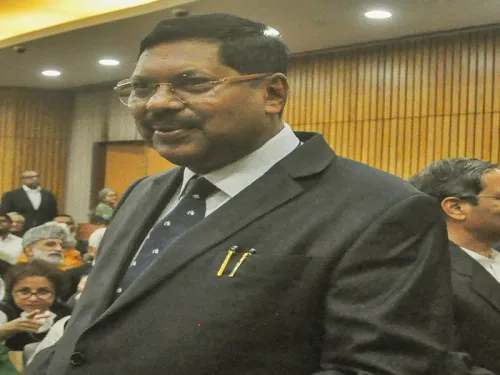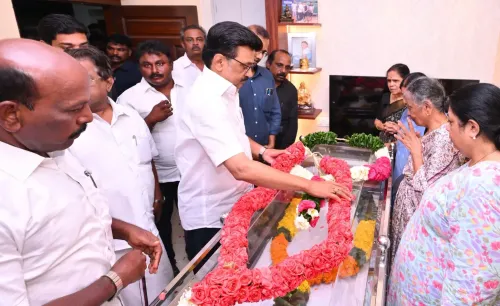How is Ajmer’s Mayo College Celebrating 150 Years?

Synopsis
Key Takeaways
- Mayo College is celebrating its 150th anniversary.
- Founded in 1875, it is known as Eton of the East.
- The college has educated many royal and influential figures.
- It features stunning Indo-Saracenic architecture.
- The anniversary celebrations will include various cultural events and performances.
Jaipur, Nov 23 (NationPress) Mayo College, regarded as Eton of the East, is commemorating its milestone of 150 years this year. Established in 1875, the college welcomed Maharaja Mangal Singh of Alwar as its inaugural student.
In a remarkable entry, Singh arrived at the school on a grand elephant accompanied by a procession of trumpeters, bearers, camels, and mounted aides, supported by a retinue of 500 servants, 12 elephants, and 600 horses.
Students from various Rajputana princely states also frequented the college, leaving behind magnificent structures that continue to narrate the tales of India's glorious past. The initiative to create a dedicated institution for the comprehensive education of young princes was proposed in 1869 by Lt. Col. F.K.M. Walter.
In the following year, Viceroy Lord Mayo refined this concept into the establishment of a prestigious 'Raj Kumar College' in Ajmer, aimed at educating the heirs of royal families. Tragically, the Viceroy was assassinated on February 8, 1872, in Port Blair, during an official visit. However, the vision persevered, and Mayo College commenced operations in 1875.
Dr. Mohit Mohan Mathur, Head of the History Department, stated in an interview with IANS that the aftermath of the 1857 rebellion made the British recognize the significance of Indian princely states as allies. Thus, Mayo College was founded to instill a blend of Indian and Western values in their heirs, fostering support for British governance. This prestigious institution has produced future rulers, military figures, diplomats, and political leaders.
The cornerstone of the college's iconic Main Building was laid on January 5, 1878, and completed in 1885, funded exclusively by royal family contributions, at a cost of Rs 3.28 lakh.
Meanwhile, Principal Saurav Sinha emphasized to IANS, “We prefer to refer to our 150-year-old institution as exclusive rather than elite, as it has preserved its rich heritage while adapting to modern trends. This school embodies a spirit where education and traditions converge. Students from various regions come together to celebrate all festivals, fostering respect for diverse cultures.”
The college exhibits a stunning example of Indo-Saracenic Architecture, with designs ranging from Greek to Kolhapur styles submitted. Ultimately, Major Charles Mant’s Indo-Saracenic design, harmonizing Mughal, Indian, and European elements, was selected. Notably, the building presents a different appearance from each angle, a characteristic that has earned it recognition in the British Museum.
Today, the campus features a polo ground, golf course, museum, amphitheater, and lavish boarding houses named after princely states. A notable highlight is a vast 1936 “On Air of India” map, which illustrates the entire subcontinent, including modern-day Pakistan and Bangladesh. Additionally, Mayo College houses a rare school museum with over 9,000 gifted items, all donated, not purchased.
Dr. Kanika Mandal, in charge of the museum, draws attention to its collection of miniature royal paintings, ancient coins and currencies, manuscripts including the Persian Anwar-i-Sohaili, an arms gallery, 240 varieties of bird eggs, sculptures, and unique craft items. Among its treasures is a silver-and-ivory crayon used to lay the foundation stone of the college in 1878 and later employed in the construction of four major buildings.
Mayo College has educated royals beyond India, including Sayyid bin Taimur, the Sultan of Oman, who attended in 1922. His nephew, Sayyid Fahir bin Taimur Al Said, studied there from 1941-47 and later became Oman’s Deputy Prime Minister, facilitating the construction of Oman House and its guest house during a visit in 1985.
Dubbed Eton of the East, Lord Lytton, then Viceroy of India, encapsulated the essence of the institution during the Annual Prize Day on December 5, 1879: “Ajmer is India’s Eton, and you are India’s Eton boys.”
HH Gaj Singh of Jodhpur, President of the Mayo General Council, noted, “The average lifespan of institutions is diminishing—from 64 years to 14 years for Fortune 500 companies. Survival for 150 years is exceptional. Mayo has thrived due to holistic education, institutional renewal, and stakeholder inclusion. This anniversary serves as a commitment for every Mayo stakeholder to be a good ancestor—by contributing time, talent, and resources to fortify the school for future generations.”
Notable alumni include acclaimed author Vikram Chandra, former diplomat Harsh Vardhan Shringla, and commentator Charu Sharma.
Gaj Singh recalls, “During Mayo’s 50th anniversary, Lord Irwin said, ‘success in the examination room is valuable but should not be the sole focus for the college.’ On our 100th anniversary, Prime Minister Indira Gandhi remarked, ‘Real achievement is not measured by rank or wealth but stems from the pursuit of excellence.’
For our 150th anniversary in November, the General Council sought a powerful role model for our students and chose public-spirited entrepreneur Nandan Nilekani as our Chief Guest. He not only co-created our software revolution—putting India ahead in software exports—but also donated hundreds of crores to his alma mater and transformed society through the Aadhaar initiative.”
The 150th anniversary celebrations will span four days from November 27-30, featuring a special assembly, art exhibitions, the launch of the Kapuriah Centre of Excellence for AI and Robotics, a polo match against Harvard, a curated fashion show, a vintage car exhibition, and live performances by Sonu Nigam, Salman Ali, and Euphoria, among others.
The main Prize Giving ceremony will occur on November 29, where Nilekani will grace the event as Chief Guest, inspiring students with his presence.
Gaj Singh concludes, “A school like Mayo may not impact a vast population in India, but it stands as a beacon of holistic education, excellence, and resilience.”









